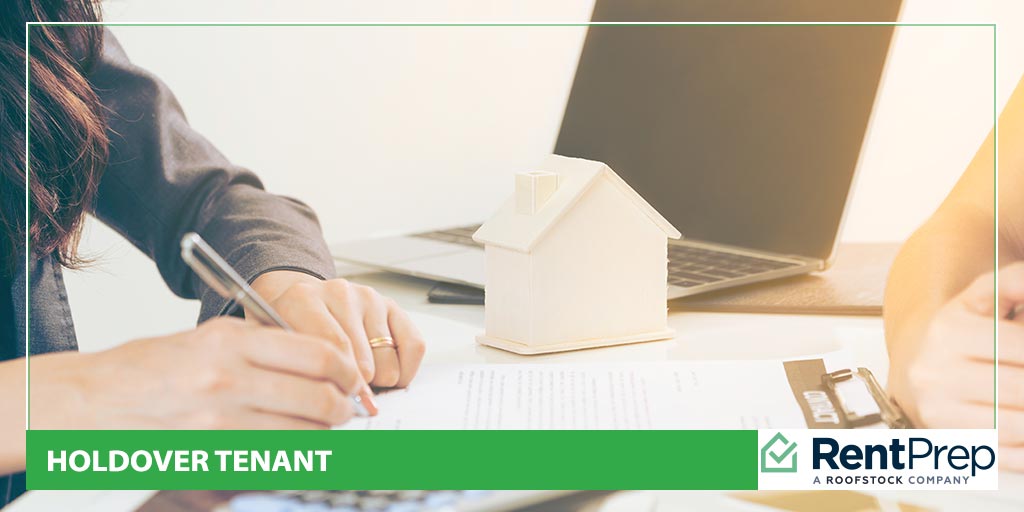
Updated July 2021
Keeping tenants on regular leases is the preference of experienced landlords, but sometimes, you end up with a holdover tenant that stays at the property beyond the official tenancy period. How can this precarious situation end up affecting your business long term?
There are potential positive and negative outcomes of this situation, but most landlords try to avoid leaving too many holdover tenant situations unresolved due to the financial risk. Avoiding impacting your rental cash flow is key, so you need to be prepared to take action when holdover situations occur.
Today, learn what a holdover tenant is, how these situations are unique, and what your options are when you find yourself dealing with a tenant that won’t leave after their lease is up. This information will quickly become a key part of your landlord knowledge bank.
A Table Of Contents On Holdover Tenants:
Unsure what holdover tenants are or how to take action to regain control of your property after ending up in a holdover situation? Browse the details of this guide to get started:
- What Is A Holdover Tenant?
- What Can I Do With A Holdover Tenant?
- How Do I Avoid Agreeing To A Holdover Term?
- My Tenant Won’t Leave After Lease: What’s Next?
- Tenants Holdover Issues FAQs
What Is A Holdover Tenant?

A holdover tenant is a tenant who stays on the property after his or her lease has expired, without the landlord’s explicit permission. A holdover tenant (sometimes incorrectly referred to as a “tenancy at sufferance”) may stay at the property as long as the landlord doesn’t take any specific actions.
Holdover tenants are a common occurrence in the rental industry, but the way that this type of situation is handled may vary from state to state due to differences in state laws. As you learn more about holdover tenants today, keep this in mind.
What Leads To A Holdover Tenant?
A holdover tenant situation develops whenever a lease expires and you do not sign a new one with your tenants. While the expired lease terms may roll over into a month-to-month situation depending on state laws, that doesn’t mean that you have the same protections for your property.
Some tenants enjoy the holdover period because it enables them to continue to live at the property without the long-term commitment, but most landlords will prefer to have a new lease signed when possible. Though the situation is similar to a month-to-month, it’s best to have a valid lease in play at all times.
Without having an active lease to outline the terms of tenancy, tenants may quickly become liabilities or cause problems. Issues like bringing in pets without permission or not paying rent properly can be difficult to resolve whenever you’re dealing with a holdover tenant.
How To Be Sure Your Tenant Is A Holdover Tenant
While holdover tenants are a fairly common situation, this type of occupancy is often confused with similar situations:
- Tenancy at will
- Periodic tenancy
Often, these terms are used interchangeably even though there is a degree of legal differentiation between them that should be acknowledged. For a better understanding of what is not considered to be a holdover tenancy, here is some more information about these similar situations.
Tenancy At Will:
Tenancy at will is when a landlord agrees that the tenant can continue to remain on the property after the lease ends. This agreement can be dissolved by either party at any time; the party that wishes to end the agreement must simply follow the state’s landlord-tenant rules for doing so.
Periodic Tenancy:
A periodic tenancy is a type of ongoing tenancy in which there is no set end date. Until both parties agree to end the tenancy, the lease will continue to be in effect. Usually, this is the type of lease agreement that takes over when an initial lease ends. Often, leases will include information about what type of periodic tenancy will be used when the lease ends.
How Long Can A Tenant Stay After The Lease Expires?
New landlords that end up in a holdover situation might wonder: how long can a tenant stay after the lease expires? Usually, this thought is in hopes of the situation resolving itself rather than needing to take any specific action.
If the landlord continues to collect rent from holdover tenants without creating a new lease, most states will recognize the tenant as having a tenancy equal to the rent payment period. For instance, if a landlord collects rent from the tenant on the first of every month even after the lease has expired, the tenant will generally be considered to have a month-to-month tenancy.
The landlord or the tenant can also terminate the agreement with one month’s notice in this situation.
Notice to terminate such an agreement must usually be the length of the rent payment period. For instance, if the rent is paid once a month, the landlord must give the tenant notice to quit at least one month before the tenant is expected to move out. If the rent is paid in a single yearly “lump sum,” most states require that notice must be given at least one year in advance.
What Can I Do With A Holdover Tenant?
Once you’re in a holdover tenant situation, it can be hard to know what action to take next. It’s important to know all of your options and act quickly so that you don’t accidentally end up in a more complex situation. So when a tenant doesn’t leave at the end of a lease, consider what your main three options are.
Option 1: Let The Tenant Stay
The first thing that you can do when a tenant doesn’t leave at the end of the lease is to let them stay on at the property. By continuing to accept their monthly rent, you are agreeing to this tenancy.
Depending on your original lease terms and local laws, this might be considered with a periodic tenancy or a month-to-month tenancy since there is no set end date for the unwritten agreement. If your original lease does not include such language, it might be in your best interest to sign a new lease instead of staying in limbo.
Once you accept rent from a holdover tenant, you will no longer be able to evict them on the basis of overstaying their lease period. Do not accept any rent from a tenant until you are sure that you are comfortable with them staying at the property longer.
Option 2: Holdover Tenant Eviction
If you do not want the tenant to continue to stay at the property, but they are still remaining there, it is time to pursue a holdover tenant eviction. In this type of eviction, the former tenant is treated as a trespasser on your property as you go through the eviction process.
Do not accept any rent from tenants that stay past their welcome as this will cause problems pursuing eviction. Instead, refuse to accept rent, and then send a notice to vacate for non-payment of rent or for violating the lease terms by overstaying tenancy.
From there, you’ll need to pursue eviction according to the rules and regulations of your local court system. Once you have a successful eviction judgment, you’ll be able to have the tenants removed from your rental property.
Option 3: Terminate The Lease Agreement
In cases where the tenant is overstaying the lease, but the lease agreement or local laws allow for some amount of holdover, you will want to officially terminate the lease. In most states, you can do this by providing notice equal to the rent payment period.
Once the tenant receives notice, they’ll have that amount of time to leave the property. If they do not leave after the lease is officially terminated, you’ll need to pursue an eviction to regain control of the property.
Make Your Choice Carefully
As noted above, you have a few different options. Which path is best for your business and rental properties is going to depend on a number of factors. Before you pursue any of these steps, ensure you are certain about your choice.
In most jurisdictions, landlords are bound to whichever option they choose. This means that you will not be able to change your mind and file for eviction immediately after accepting rent from a tenant. Take time to parse out your plan before taking action; you’ll be better off if you are well prepared.
How Do I Avoid Agreeing To A Holdover Term?

The easiest way to avoid accidentally agreeing to a holdover term is to refuse to accept any rent payment after the date the lease ends unless it is a payment for rent due under the lease (for instance, a payment for back rent).
For example, if the lease ends on December 31, the landlord should not accept a rent payment from a holdover tenant for January of the next year unless a new lease is signed.
Accepting rent is a signal that the landlord agrees to convert the tenancy into a month-to-month or similar agreement.
Another thing that you can do to ensure that you don’t accidentally find yourself in this situation is to ensure that your lease terms are very clear on what will happen at the end of the tenancy period. Some leases include terminology which automatically converts a lease into a month-to-month agreement. Regardless of what the lease says, make sure it is clear and lines up with what you want to happen if a tenant overstays their lease.
Clarity is key throughout every stage of the lease process, and that clarity can be very helpful if a tenant attempts to continue to stay at the property past their welcome. Make sure that your lease is kept up-to-date with the terms that best fit your needs.
Be Careful When Buying
Are you considering investing in a rental property that already has tenants living there? It is important to take some precautions in this situation to ensure that you do not accidentally take on holdover tenants.
You should do more than just ask the current owner what the lease type is. As mentioned, landlords often use different terminology to mean the same things, and this can lead to confusion on what is really happening at the property. Rather than just asking, it’s best to get written information from all involved parties.
Specifically, you can request that the seller’s agent have tenants fill out an Estoppel Agreement. This agreement is a declaration of rental information which will let you know the lease terms, rent amount, and any other agreements that the tenant believes are in place.
Getting this information from the tenant before buying the property is a great way to get a better idea of the property’s status, but tenants aren’t required to fill out this disclosure. Some may not be on a lease or they may not believe they are required to disclose this information.
If a tenant is unwilling to fill out an estoppel agreement, you might want to reconsider your options to invest in this property as it could be a sign of a difficult landlord-tenant relationship. At the very least, ask the current owner for copies of the lease that you will be taking over before buying. This ensures you won’t be in a holdover situation.
My Tenant Won’t Leave After Lease: What’s Next?
If you have found yourself in a holdover situation where the tenant won’t comply with your requests to move out and there are no holdover clauses in the lease that permit them to stay, it’s time to move forward with eviction.
Evicting a holdover tenant is not as difficult or hopeless as you might worry it is; here’s what you need to know.
How To Evict A Holdover Tenant
Evicting a holdover tenant may be slightly different in your state than evicting a tenant under a provision in a lease.
To evict a holdover tenant, the landlord must treat the tenant as a trespasser who does not have permission to be on the property and who is acting wrongfully by staying on the property from the moment the lease ends.
The best way to deal with a trespasser will depend on the laws of your state and locality. Consult an experienced attorney in your area for specific tips on how to evict a holdover tenant.
Despite the difference in the reason and timing of each step, the general eviction process doesn’t change much. First, you’ll need to send an official notice to the tenant. This document outlines what you expect to happen and what will happen if the tenant does not comply.
In some cases, this document might be enough to convince the tenant to move out or to resign their lease. This is the first thing that you must do.
If the tenant doesn’t respond to the notice to cure, you’ll want to escalate to a notice to vacate. This notice gives the tenant reasons as to why they must leave and when they must leave by. It also informs the tenant that an eviction suit will be filed if the tenant does not comply.
If the tenant does not comply, it’s time to file that eviction suit. Your local court system will provide the structure for this process. Make sure that you follow all necessary steps to avoid any accidental delays in the proceedings.
Protecting Your Properties
As you can see, the process of dealing with holdover tenants and the subsequent evictions can be complicated. One great way to avoid dealing with this situation altogether is making sure that you have your lease and other documentation updated with clauses to protect your properties.
If you’re not sure where to start with making your forms, check out RentPrep’s Landlord Starter Form Kit today. This great kit can kickstart the process of improving all future documentation.
Tenants Hold Over Issues FAQs
What is the difference between a holdover tenant and a tenant at sufferance?
The terms holdover tenant and tenant at sufferance are often used interchangeably; is there actually a difference between these two things?
As mentioned above, a holdover tenant is a tenant that stays beyond the lease period without the explicit permission of the landlord. In its essence, this term is neither positive or negative. It simply expresses the situation.
Tenant at sufferance, however, is a term typically used in a negative way to express when a tenant stays at the property past when they have been given permission, and the landlord is not in agreement about it. Still, the landlord has not yet filed for eviction.
Another term that can become confusing in all of this is the term tenancy at will. The difference between these two terms is consent. A tenant becomes a tenant at will whenever they are permitted to stay past the original lease period; their agreement is now on an at-will basis with the landlord in agreement.
What is a periodic tenancy?
A periodic tenancy has no defined endg date as the “term” keeps rolling over and over. If neither the tenant nor the landlord gives the other sufficient notice, the tenancy will repeat depending on what its initial periodic setup was.
For example, if rent was paid monthly, the periodic tenancy would be a month-to-month tenancy. If rent was paid weekly, the periodic tenancy would be week-to-week.
What do I do when a lease expires, but tenant won’t leave?
If the lease expired and the tenant won’t leave, you’ll need to either file an eviction or let the tenant be. If you do nothing, then the tenant will become a holdover tenant as discussed earlier in this post. If you’re going to proceed forward with an eviction, be sure to follow all the proper legal procedures.
Don’t Panic: Handling It When Tenants Hold Over
As today’s guide to handling this challenging situation wraps up, it’s important to remember one thing above all else. Don’t panic!
By taking time to ensure that you are acting logically and according to the appropriate procedures for holdover tenants, you can easily make your way through this situation. The biggest issue for most landlords when they first experience a case of holdover is that they don’t know what to do.
Now, with the help of this simple guide, you can choose the best path for taking care of your rental properties. Do you have any other tips or questions about holdover tenants? Join the discussion in the comments today.

